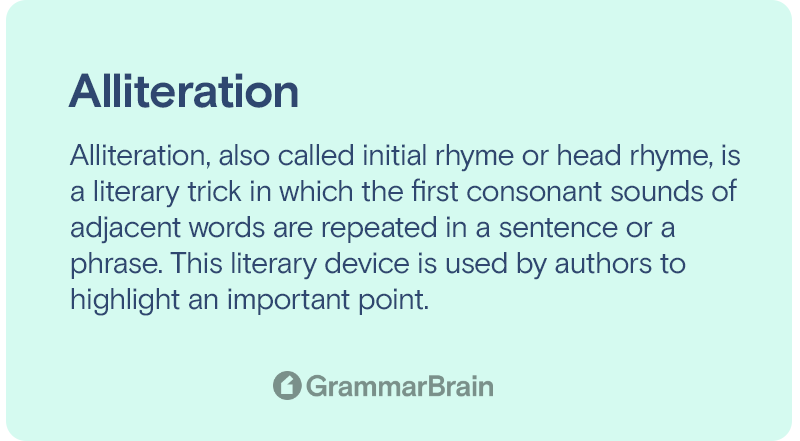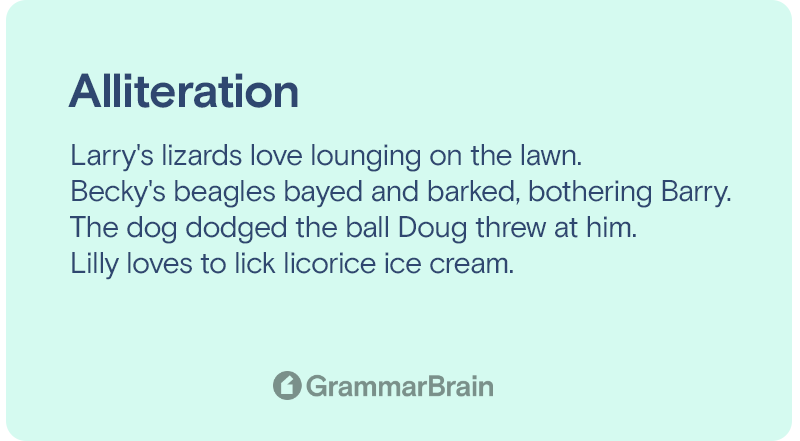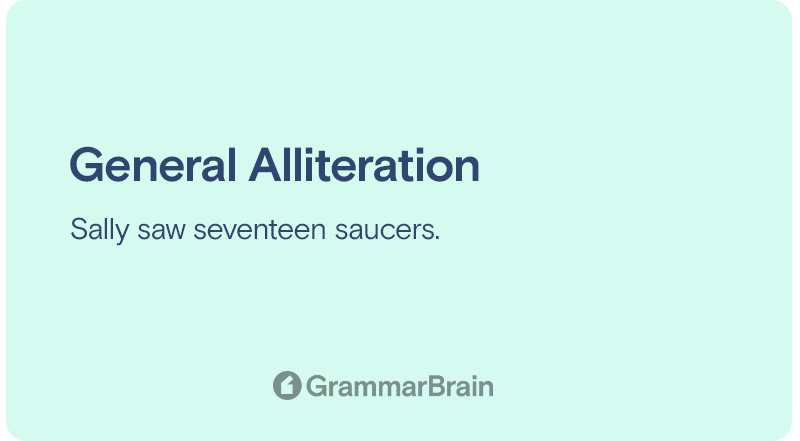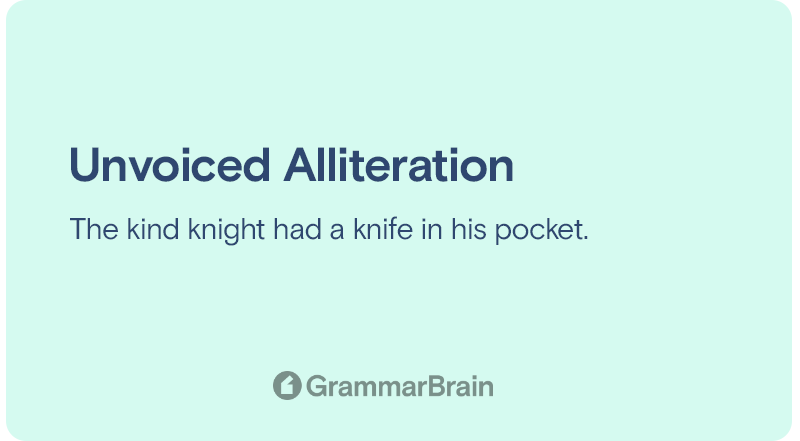Alliteration is a great way to learn English. The poetic device helps us see how beautiful the natural language can become. But what about when we need to teach it to kids? These alliteration examples for kids are perfect for teachers, parents, and other educators who want to show children how wonderful alliteration can be.

What is alliteration?
Simply put, alliteration is a poetic device that refers to the frequent occurrence of the initial consonant sounds at the beginning of nearby words in a phrase. Sometimes, alliteration is also called “head rhyme” or “initial rhyme.”
For example, consider this familiar phrase from a popular tongue twister: “Sally sells seashells by the seashore.” Here, the consonant sound “S” is repeated frequently.

Why is alliteration important for children?
Alliterations are usually taught in primary schools all across the world. They help young children in understanding the English language in a better way. For this reason, alliterations are heavily used in nursery rhymes and tongue twisters.
Teachers and parents often use alliterations to draw the children’s attention to something important in a sentence, help them learn specific words, and make learning fun for them. Alliterations also enable the children to identify how different words sound and implement their learning to their own pronunciation.
The major goal of alliteration is to make difficult words sound easier to children, help them in developing their speech, and boost their reading abilities.
The best alliteration examples for kids
Alliterations are used in multiple ways to help kids understand different words and recognize different sounds in a speech. They are used in the forms of rhymes, funny tongue twisters, and more.
Here are some popular alliteration examples that will make learning more enjoyable and easy for the little ones:
Alliteration examples in sentences
- Cole closed the closet clumsily
- Go and gather the green grass
- Please practice the piano
- Barry baked a big cake at the bakery
- Barry, the boy is as busy as a bee
- Rachel ran round, round, and round
- Little Layla like looking around
- Lazy lizards are lying on leaves
- Paula painted the parlor pink
Alliteration examples in popular stories and nursery rhymes
Alliterations have been used in rhymes for ages. They make the rhymes easier and more interesting for kids. As the same sound appears multiple times, children are better able to understand them, identify them, and learn them faster.
Alliterations are usually used to grab the reader or listener’s attention and inject a sense of harmony into the poem. They make the rhyme more lively and fun for kids. Sometimes, alliterations are also used to make a poem funny.
Let’s have a look at some of the most popular alliteration examples in rhymes that are commonly thought to kids:
- “Three grey geese in a green field grazing. Grey were the geese and green was the grazing.” – from the poem “Three Grey Geese by” Mother Goose
- “Betty Botter bought some butter, but she said, this butter’s bitter. If I put it in my batter, it will make my batter bitter, but a bit of better butter will make my batter better.” – from the poem “Betty Botter” by Carolyn Wells
- “My counters and cupboards were completely cleared of carrot cake, cornbread, and crackers.” – from Betty’s Burgled Bakery by Travis Nichols
Alliteration examples in popular tongue twisters
Another common use of alliteration can be found in tongue twisters. In fact, the phrase “Tongue Twister” is alliteration in itself.
Alliterations are used in tongue twisters to make them a bit tricky and funny for children. Reading an entire tongue twister without stumbling in between is challenging. And since kids enjoy achieving goals, teachers often use tongue twisters to enhance their children’s vocabulary.
Here is a list of some popular tongue twisters that heavily use alliterations:
- “Peter Piper picked a peck of pickled peppers. If Peter Piper picked a peck of pickled peppers, where’s the peck of pickled peppers Peter Piper picked?”
- “Silly Sally swiftly shooed seven silly sheep. The seven silly sheep Silly Sally shooed shilly-shallied south. These sheep shouldn’t sleep in a shack.”
- “A good cook could cook as many cookies as a good cook who could cook cookies.”
- “A woodchuck would chuck as much wood as a woodchuck could chuck if a woodchuck could chuck wood.”
- “The great Greek grape growers grow great Greek Grapes.”
- “Black bug bit a big black bear. But where is the big black bear that the big black bug bit?”
- “Sally sells seashells by the seashore. She sells seashells on the seashell shore. The seashells she sells are seashore shells, of that I’m sure.”
- If colored caterpillars could change their colors constantly could they keep their colored coat colored properly?
- If practice makes perfect and perfect needs practice, I’m perfectly practiced and practically perfect.
Alliteration examples in popular cartoon and movie characters
Not only in rhymes and tongue twisters but alliteration examples can also be found in the name of popular cartoon characters.
Here are some popular alliteration examples in cartoon characters:
- SpongeBob SquarePants
- Bugs Bunny
- Donald Duck
- Elmer Elephant
- Woody Woodpecker
- Huckleberry Hound
- Peter Parker
- Peppa Pig
- Rebecca Rabbit
How to write alliterations for kids
As discussed, using alliteration can make learning more fun and effective for preschool kids. Thus, teachers and parents should try to include alliteration in their child’s English vocabulary lessons as often as possible.
Coming up with alliteration poems seems tricky. However, it becomes a lot easier with the right tips and strategies. If creating their own alliteration poems or phrases, preschool teachers should use the following tips:
- An alliteration poem or phrase should always be started with a consonant. The writer must ensure to pick a consonant like “C,” “P,” “T,” etc., and not a vowel. It is important to give enough thought before picking a consonant because the writer will have to include words beginning with that consonant frequently throughout the poem.
- Once the consonant is finalized, the writer should start thinking about as many words as they can that begin with their selected consonant. These words can be nouns, verbs, or adverbs.
- Once they have a handful number of words, the writers should start forming sentences using these words. It is okay to add a few words that begin with a different letter in between.
- As much as possible, it is important to make rhyming sentences.
One of the most important things about alliteration is that alliteration is not only the reputation of consonants but also their sound. Thus, choosing words that begin with the same consonant and sound similar is crucial while writing an alliteration poem.
Alliteration (images)



FAQs
1. What is alliteration and give example?
Alliteration is the frequent repetition of initial consonant sounds in nearby words within a sentence. Here, “nearby” refers to words that are generally consecutive, but don’t necessarily have to be.
Alliteration is generally used in nursery rhymes and tongue twisters. Their main purpose is to grab the reader’s or listener’s attention to a particular part of the sentence.
Some common examples of alliteration include:
- I saw a saw that could out saw any other saw I ever saw.
- A good cook could cook as many cookies as a good cook who could cook cookies.
2. Which cartoon character name uses alliteration?
Due to their obvious popularity amongst children, most cartoons and children showed leverage alliteration to make their characters memorable.
Here are a few cartoon character names that use alliteration:
- Micky Mouse
- Donald Duck
- SpongeBob SquarePants
- Woody Woodpecker
- Green Goblin.
- Bugs Bunny.
Sources:
- Merriam-Webster Dictionary – Definition
- Your Dictionary – Alliteration Examples for Kids
- Grammarly – All About Alliteration
Inside this article
Fact checked:
Content is rigorously reviewed by a team of qualified and experienced fact checkers. Fact checkers review articles for factual accuracy, relevance, and timeliness. Learn more.
Core lessons
Glossary
- Abstract Noun
- Accusative Case
- Anecdote
- Antonym
- Active Sentence
- Adverb
- Adjective
- Allegory
- Alliteration
- Adjective Clause
- Adjective Phrase
- Ampersand
- Anastrophe
- Adverbial Clause
- Appositive Phrase
- Clause
- Compound Adjective
- Complex Sentence
- Compound Words
- Compound Predicate
- Common Noun
- Comparative Adjective
- Comparative and Superlative
- Compound Noun
- Compound Subject
- Compound Sentence
- Copular Verb
- Collective Noun
- Colloquialism
- Conciseness
- Consonance
- Conditional
- Concrete Noun
- Conjunction
- Conjugation
- Conditional Sentence
- Comma Splice
- Correlative Conjunction
- Coordinating Conjunction
- Coordinate Adjective
- Cumulative Adjective
- Dative Case
- Determiner
- Declarative Sentence
- Declarative Statement
- Direct Object Pronoun
- Direct Object
- Diction
- Diphthong
- Dangling Modifier
- Demonstrative Pronoun
- Demonstrative Adjective
- Direct Characterization
- Definite Article
- Doublespeak
- False Dilemma Fallacy
- Future Perfect Progressive
- Future Simple
- Future Perfect Continuous
- Future Perfect
- First Conditional
- Irregular Adjective
- Irregular Verb
- Imperative Sentence
- Indefinite Article
- Intransitive Verb
- Introductory Phrase
- Indefinite Pronoun
- Indirect Characterization
- Interrogative Sentence
- Intensive Pronoun
- Inanimate Object
- Indefinite Tense
- Infinitive Phrase
- Interjection
- Intensifier
- Infinitive
- Indicative Mood
- Participle
- Parallelism
- Prepositional Phrase
- Past Simple Tense
- Past Continuous Tense
- Past Perfect Tense
- Past Progressive Tense
- Present Simple Tense
- Present Perfect Tense
- Personal Pronoun
- Personification
- Persuasive Writing
- Parallel Structure
- Phrasal Verb
- Predicate Adjective
- Predicate Nominative
- Phonetic Language
- Plural Noun
- Punctuation
- Punctuation Marks
- Preposition
- Preposition of Place
- Parts of Speech
- Possessive Adjective
- Possessive Determiner
- Possessive Case
- Possessive Noun
- Proper Adjective
- Proper Noun
- Present Participle
- Prefix
- Predicate



